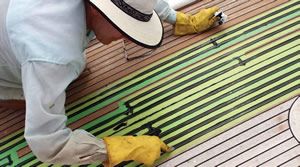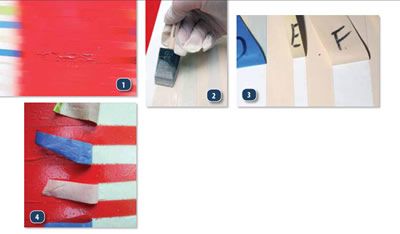Most sailors have discovered that when it comes to applying marine coatings, masking tape is as important as a paintbrush if you want straight lines, smooth curves, and clean edges. Today, the term masking tape has become a catch-all for a combination of adhesive-coated paper or plastic backing that comes in 60-yard rolls ranging in width from a quarter-inch to 2 inches.
The brainchild of 3M-thinker Dick Drew, the product got its start in 1925 when Drew visited an autobody shop to market the companys latest sandpaper innovations. Two-tone cars were the rage of the day, and cutting an edge using butcher paper and a high-stick adhesive tape damaged the taped over surface. The cut line was fuzzy and the tape often took off as much paint as it left behind. Back in the lab, scientists and engineers of the 3M Co. came up with a mid-range adhesive and a means of evenly spreading it on a paper backing-and so 3M, a company formerly known just for its abrasives, branched out into coatings preparation and adhesive innovation, an industry niche it continues to lead today.

Photo courtesy of Mahina Expeditions
In recent years, the popularity of special-purpose tapes has grown. These products vary in their backing material and in the tenacity of their adhesive. For example, 3M Fine Line tape (No. 218) comprises a vinyl backing and a very solvent-resistant adhesive. Not only does it have better curve-conforming characteristics, but it stays stuck, even when two-part, MEK-solvent laden paint flows over the surface. At the opposite end of the spectrum are paper-backed, low-stick adhesive tapes that facilitate a decent cutting edge, if one doesn’t look too closely. But low stick tapes have two big pluses: They are less likely to pull off older varnish or paint, and they cost a fraction of the price of fine-line tape. The bottom line is that there are enough differences among the many tape types that we felt the time had come to take a close look at whats on the market and to see how they compare.

www.mahina.com
What We Tested
In past tape tests, weve evaluated a sampling from several makers-3M, Intertape, and Henkel-and we even included generic masking tapes and black electrical tape. While Intertapes ProMask Blue got the top pick in 2004, it was by a small margin, and overall, 3Ms products have dominated the evaluations over the years. They are also the must-have choice of most boatyards and varnish and paint professionals. In fact, Karen Russell, who has been a varnish pro for more than three decades, swears by 3Ms masking tapes and will only use their products.
With that in mind, we limited the test field this time to 3M masking tapes designed to suit the maintenance needs of most boat owners. This approach also enabled us to determine which 3M product is the best choice for specific tasks, like topside painting, varnishing, long-term projects, etc.
A global powerhouse, 3M Co.s product lines run the gamut-ranging from medical supplies and fabric treatments to sponges, electronics components, and Post-It notes. A flip through the 3M catalog revealed 584 masking tape options, but a walk through local chandleries and hardware stores narrowed down the options considerably. In the end, we tested eight 3M masking tapes marketed for use in marine maintenance applications. These included the prolific blue and green masking tapes, as well as some tan-colored general painters masking tapes. With the exception of the 3M 471, all the test tapes come in 60-yard rolls with widths ranging from a half-inch to 2 inches. The 471 comes as a 36-yard roll. All of our test tapes were three-quarters inch in width.
How we tested
Our approach to tape testing began with an evaluation of handling characteristics that focused on how the tape spooled off the roll, its adhesion, and how it peeled up after painting. Testers focused on whether a product tended to tear or spool off the roll evenly, whether it established adequate adhesion with just a single fingertip press, and whether it could be removed from the surface without repeated breaks in the backing.
Testers applied each tape to fiberglass panels in straight lines and gently arcing curves, using consistent press down efforts. Testers then brushed on one-part modified marine enamels to one test panel and sprayed on high-volatility coatings on another set of test panels. In both tests, the tape was partially removed just after application, then completely removed after the paint fully cured, and the cut edges were compared.
During removal, any tapes tendency to tear and not release was noted, along with signs of paint migrating under the tape. Testers also noted any paint lifting from the surface and any adhesive tape residue being left behind.
The tapes were applied to a third set of test panels to determine their resistance to three grades of solvent: Interlux 333, a one-part paint reducer; Interlux 202; and the least aggressive, methyl ethyl ketone (MEK), a very fast evaporating chemical present in spraying reducers such as Interlux 2316N. Testers noted the solvents effect on tape backing and adhesive.
To get an idea of how well the tapes stood up to weathering, we applied them to test panels and left them outside for weeks. Tape deterioration was measured at three-day, one-week, and three-week intervals. Testers noted ease of removability, deterioration of backing, and the amount of adhesive residue left behind. The recommended durations listed in the Value Guide reflect our test findings.

3M 2090 Blue
The 3M 2090 Blue Painters Tape is a medium-adhesion, paper-backed masking tape that removes cleanly from surfaces up to seven days after application. Its a water-, solvent-, and sunlight-resistant masking tape that has become generic among sailors.
Theres good reason why this tape seems ubiquitous in boatyards across the country. Its an all-around good performer, and the price point is right. Testers found the 2090 tapes backing had enough tensile strength to keep frustrating tears-on-the-roll and tears-on-the-surface to a minimum.
The 2090 performed well with one- and two-part linear polyurethane (LPU) paints, as long as the tape was pulled sooner rather than later, but the paint edges werent as sharp and clean as those made with fine line tape or the 471 tape. If users pay a little extra attention to pressing down the tape edge prior to painting, the 2090s edging ability is very acceptable.
At $3.74, it had the lowest price per roll, and tied the 2050 and 2025 tapes for the lowest per-foot price.
Bottom line: A boatyard favorite, the 2090 is an excellent general-purpose tape for paint and varnish masking. It gets the PS Budget Buy and is the Recommended pick for a multi-use tape.
3M 2080 Blue
The 3Ms 2080 Blue Painters Tape is a relatively thin, paper-backed, low- to medium-adhesion tape that makers claim can be left on a surface for several weeks. It is sunlight resistant and is recommended for both interior and exterior use.
The manufacturer explains that 2080 is ideal for most smooth or delicate surfaces, such as recently painted topsides, varnished woodwork and other smooth surfaces. However, we found that it was not a good choice to use atop marginally adhered substrates for extended periods.
The 2080s smooth backing and finer paper is strong enough to resist tears, partly because the adhesive isn’t very tenacious initially. The tapes thin edge delivers a crisply cut line, and although its not quite fine-line perfect, it comes pretty close. The tape also did well in our resistance to weathering test.
At $5.99 per roll, it runs about 3 cents per foot.
Bottom line: This is another big winner in 3Ms blue tape line. We Recommend it for long-term projects that require the tape to be left on for weeks.
3M 233 Plus Green
The 233 Plus masking tape is a bright green, high-performance, crepe paper-backed tape with rubber adhesive. It is water and solvent resistant, and in tests, it did not leave behind adhesive residue. The 233 Plus is not designed for use outdoors for more than one day, and the minimum application temperature is 50 degrees.
The tape can be used on deck or below, and it is often the professionals choice when it comes to masking off the boot top prior to bottom painting. Its also handy for brightwork edging and other general short-term edging needs as well. Its another general-purpose masking tape that offers clean, easy removal as long as it is not left on a surface for extended periods.
Easy and convenient to handle, 233 Plus offers a few unanticipated upsides. Its a high-contrast color, which enables a painter to be more aware of the line being scribed by the tape. The bright, eye-catching color draws the painters eye to the delineation between tape and paint as a boot top or waterline is coated, lessening the chance of leaving a bare spot in the wake of a brush pass.
At 3 cents per foot, the 233 Plus fell in the middle of the pack pricewise.
Bottom line: As far as line-cut quality, tape handling, and weather resistance, testers preferred the blue tapes over the green 3M 233 Plus.
3M 218 Fine Line Blue
Paint professionals weve spoken with prefer using 3Ms 218 Fine Line blue masking tape when spraying or brushing on LPU paints. Teak-deck installers also use it as a bond-break liner underneath caulking with polysulfide caulk beads. (Using a bond breaker compensates for expansion and contraction between wood and caulk.) The 218 stretches for smooth curves and tears easily. However, its not for extended outdoor use of more than one day.

In tests, the adhesive was very solvent tolerant, and it also resisted sticking to and lifting new paint. The 218 Fine Line tape was also moisture resistant and could be pulled from the surface when the paint was wet or dry. The 218 delivered the most exacting color separation and clean edges in our tests. In tests, we counted tiny points of paint intrusion into the tapes adhesive areas and noted that handsdown, the 218 had the fewest.
The 218 Fine Line is expensive (8 cents per foot), but it does the job. A good strategy is to use the 218 with one run of less-expemsive masking tape to widen the surface protection. (See Tape Tips for more on selecting the best tapes for a project.)
Bottom line: The 218 Fine Line leaves behind the sharpest delineation between areas. If youre intent on deriving a perfect edge, 218 Fine Line is the tape of choice. We Recommend it for those times when a crisp, clean edge is a priority over price.
3M 471 Plastic
The 3M 471 Plastic tape is a multiple-use tape thats designed to work as a long-term mask for painting bootstripes and other applications. It is a blue vinyl, medium-adhesive tape that can be left on a surface for up to one month, according to 3M. The specially formulated rubber adhesive will deliver clean removal and is a good choice when the tape must remain on the surface for several weeks and still needs to deliver a crisp edge.
The 471 is highly conformable and resistant to heavy abrasion and common solvents, but some of the more aggressive, two-part paint reducers can wreak havoc with the tapes backing and adhesive. Test it before committing it to a big job.
In testing, the plastic 471 demonstrated very good weathering longevity, very nice edging ability, and nearly excellent solvent resistance. We say nearly excellent because it showed great solvent tolerance until testers sprayed an acrylic-urethane paint over one of the test panels; then we watched in amazement as the tape shriveled, and its edge lifted and destroyed any semblance of a clean-cut edge. This single failure seemed linked to the paints reducer, which contained dimethyl succinate and dimethyl gluterate. In all other testing, the tape was a standout.
Bottom line: The 471 was a top performer, but at 21 cents per foot, it was by far the most expensive tape we tested.
Painters Tapes
We also tested some traditional tan-colored 3M masking tapes picked from the shelves of our local hardware store. General painters tapes 2025, 2050, and tan 233 (not the 233 Plus) are no frills, crepe-paper backed, medium- to high-adhesive tapes that offer plenty of attributes boat owners look for when spiffing up the boat with a paint and varnish makeover. The manufacturer recommends removing these products in three to five days, but we found it best to remove the tapes the same day, especially if any rain was in the picture.
These hardware-store standards proved to be a useful threesome of masking tapes. Varied in their adhesive tenacity, the tan painters tapes conformed well to most surfaces and offered decent, clean-cut lines-but not of the quality achieved with fine line or blue tapes.
The 2025 delivered a very crisp edge, but its medium-high adhesive caused the tape to be the most tear prone of all we tested. The best use of this product is behind the edge masking, where good stick really matters in keeping masking paper out of the paint when the wind pipes up. The tan 233 also delivered a useful set of all around characteristics, as did 3M 2050.
Bottom line: The 2025, 2050, and tan 233 all lacked long-term outdoor resilience, but when used as day-tape applied and peeled off in a non-rainy 24-hour period, they more than met expectations.
Conclusion
The blue test tapes nosed out the others thanks to their mechanical and chemical attributes. The combination of handling ease, a clean-cut edge, good solvent resistance, and a cost-effective price point nudged 3Ms 2080 and 2090 to the front of the pack.
For the gifted brush-handler or spray-painter, 3Ms 218 Fine Line may be worth the extra cost. It was the handsdown winner of the best-cut-line award. But if the tape must stay on the surface for more than a day-or up to a couple of weeks-the other vinyl tape we tested, 3M 471, is a better choice. However, take note of the problem we had with a spray-paint solvent, and be sure to do a test strip with reduced paint before beginning a full-blown project.
Those on a tight budget may want to go hardware-store hunting for bargains on 3M general-purpose masking tapes. Look at the length of the roll, tape width, and recommended use-not just the price tag. Some consider black electrical tape to be another budget-friendly option, but as we found in the 2004 tape comparison, it likely will leave some residue where its edges adhere to the surface, and when firmly pulled during application, it deforms through stretching, especially in hotter weather. Add to this, the necessity to cut rather than tear the tape at the end of each pull, and you can see why its no longer on our list of budget buys.
With all masking tape, you use it only once and throw it away so choosing the cheapest tape seems logical-however, the masking tape you use can make or break a time-consuming and costly paint or varnish job, so be sure to choose accordingly.







































